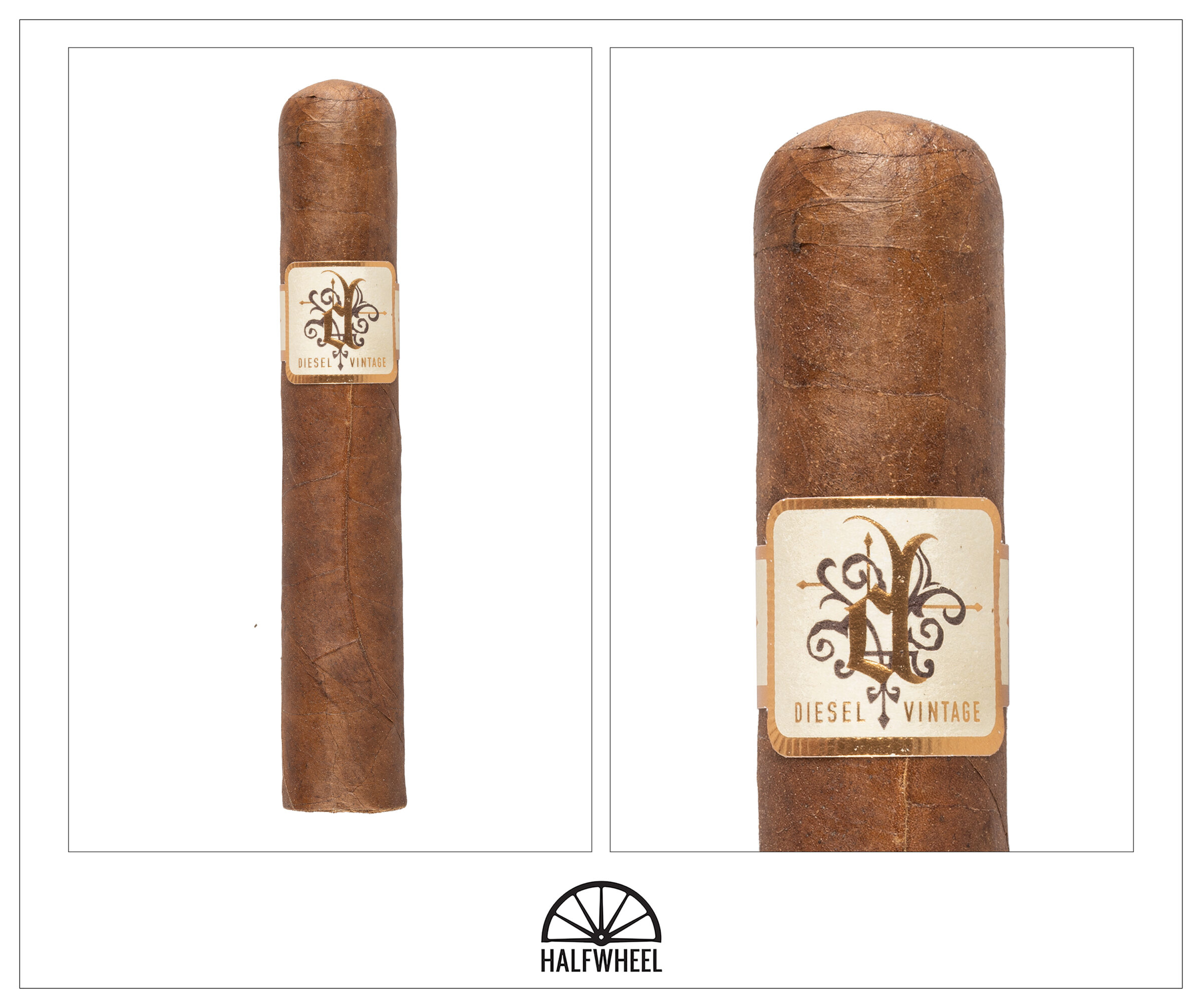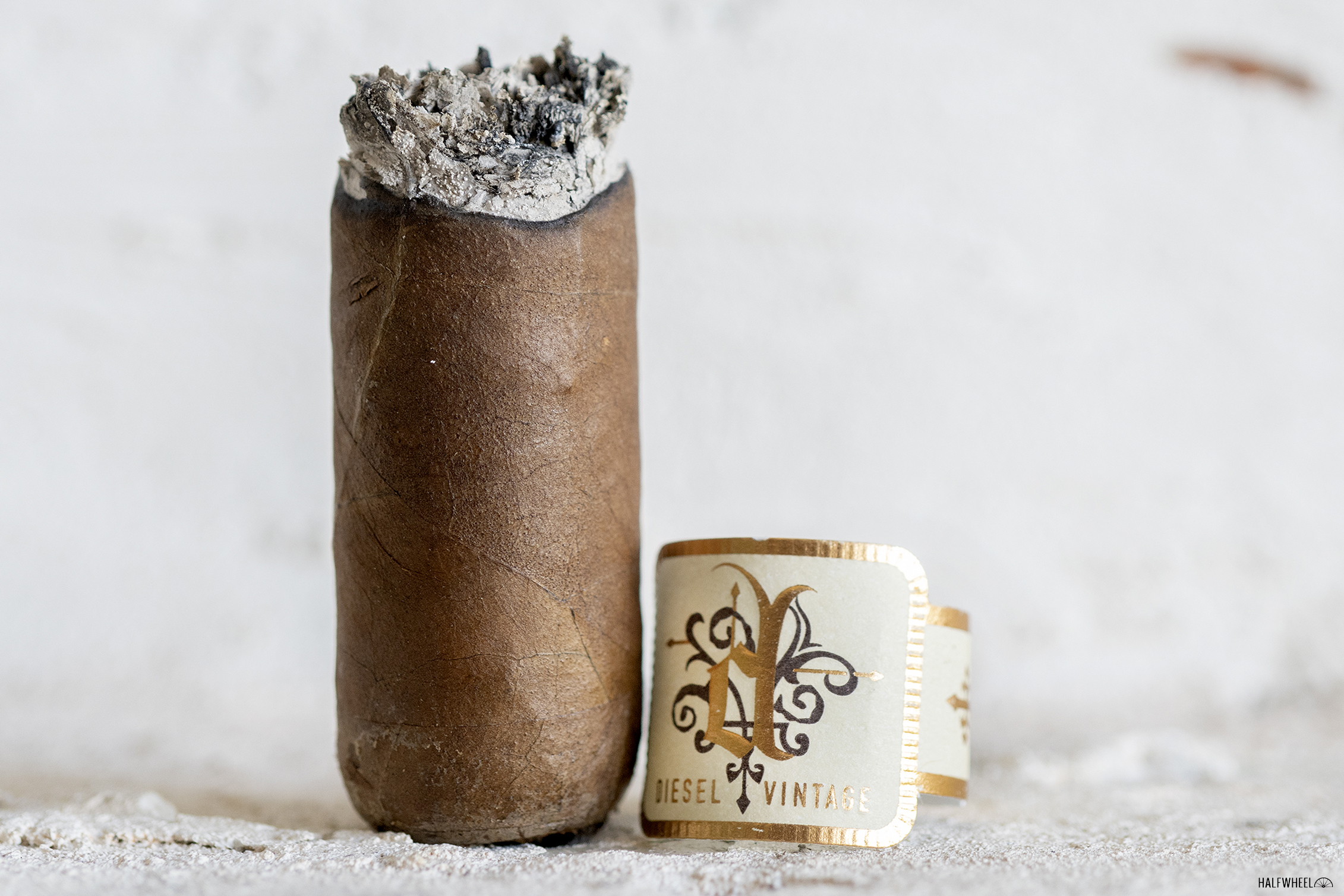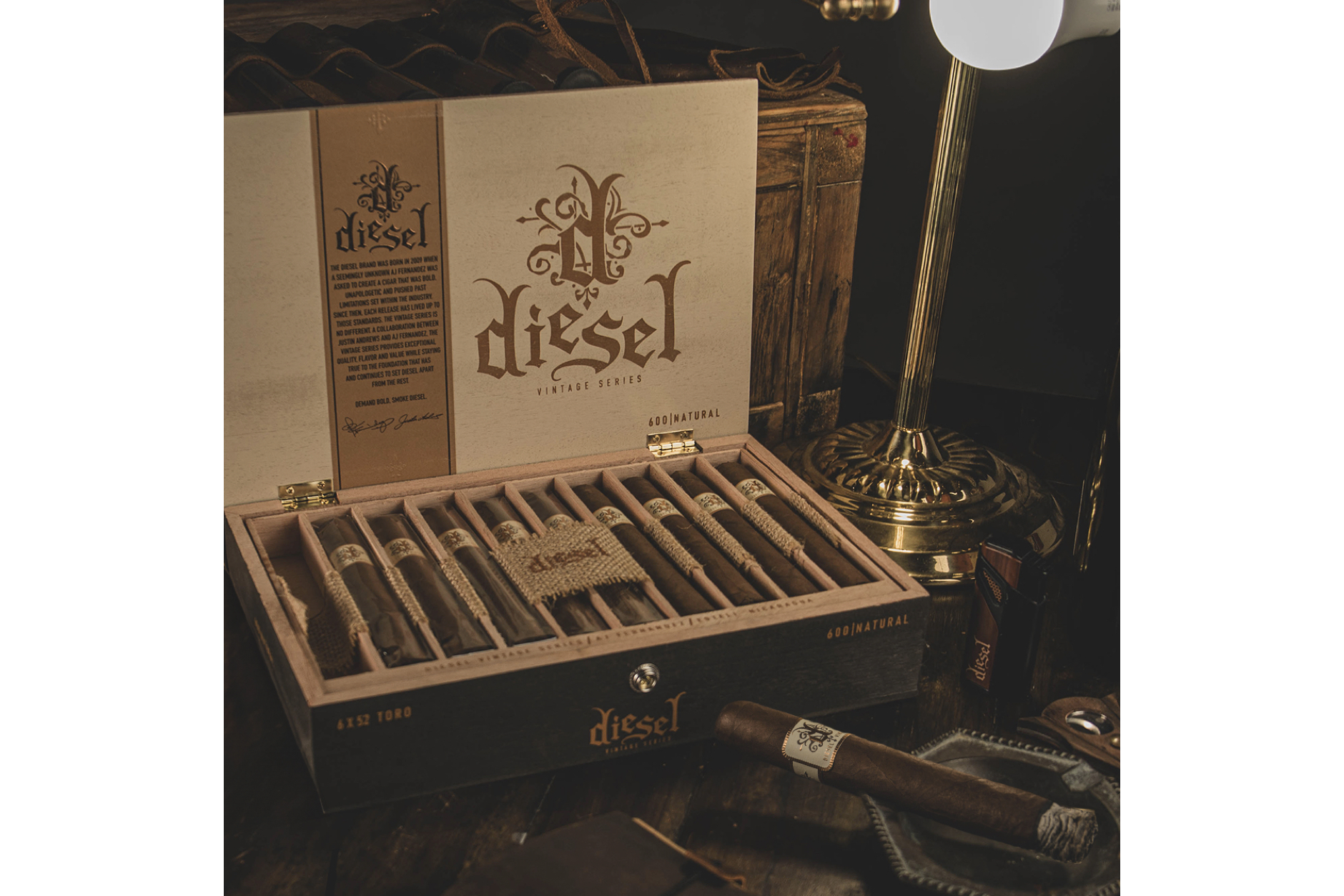Last year, General Cigar Co./Forged Cigar Co. introduced the Diesel Vintage Series, a new line with a blend capped off by a Mexican San Andrés wrapper and using 5-8-year-old filler tobaccos.
In March 2024, the company added the Diesel Vintage Natural, a new line using an Ecuadorian wrapper over a habano binder from Estelí, Nicaragua and 5-7-year-old fillers from Jalapa, Nicaragua.
Like other Diesel cigars, both lines are made at Tabacalera AJ Fernandez Cigars de Nicaragua S.A.
Both blends are offered in the same five sizes, priced the same:
- Diesel Vintage Series Natural Pico Gordo (4 1/2 x 60) — $8.79 (Box of 20, $175.80)
- Diesel Vintage Series Natural Robusto Gordo (5 x 56) — $7.79 (Box of 20, $155.80)
- Diesel Vintage Series Natural Toro (6 x 52) — $7.99 (Box of 20, $159.80)
- Diesel Vintage Series Natural Double Corona (7 3/4 x 49) — $8.79 (Box of 20, $175.80)
- Diesel Vintage Series Natural Rabito (6 x 46) — $9.29 (Box of 10, $92.90)
“For Diesel Series Natural, AJ and I took the opportunity to highlight the aged tobacco in the blend,” said Justin Andrews, business development manager of Scandinavian Tobacco Group’s (STG) North American Branded and Rest of World divisions, in a press release when the cigar was announced in February. “We introduced a natural wrapper to deliver a transformative effect on the blend and make the aging of the filler more pronounced. The result is a cigar that not only delivers the signature, bold experience that Diesel is known for, but also introduces layers of rich and satisfying complexity.”

- Cigar Reviewed: Diesel Vintage Series Natural Robusto Gordo
- Country of Origin: Nicaragua
- Factory: Tabacalera AJ Fernandez Cigars de Nicaragua S.A.
- Wrapper: Ecuador (Habano)
- Binder: Nicaragua (Estelí)
- Filler: Nicaragua (Jalapa)
- Length: 5 Inches
- Ring Gauge: 56
- Vitola: Robusto Gordo
- MSRP: $7.79 (Box of 20, $155.80)
- Release Date: March 1, 2024
- Number of Cigars Released: Regular Production
- Number of Cigars Smoked For Review: 3
Thankfully, the two lines don’t use the same exact packaging. The original has a grayish background color to the band, whereas the new cigar has a pale cream-colored band. While I’m pretty sure I could accurately guess which blend was which if the cigars were side-by-side, it’s not like the Diesel Vintage Natural’s wrapper is all that light. The aromas from the wrappers are medium-full, though, outside of a barnyard note, there are not many similarities between how the three smells. Leather and barnyard lead one cigar, pine is the strongest scent of another, and a pungent barnyard is the strongest scent for the third. The scents from the feet range from medium-full to full. All three have a sweet tobacco note, which reminds me a lot of chocolate, leading to a very generic woodiness. The smells of the feet are remarkably similar—just the one-two punch of the chocolate and woody scents—though there’s some differentiation in texture. Cold draws are medium-full. Two cigars are led by oatmeal with white pepper and black tea as accents. The other cigar has flavors that remind me of an aging room—ammonia, cedar, sweet chocolate—along with some graham cracker sweetness. Two cigars have slightly open draws, while the other cigar has a slightly tight draw.
In terms of draw resistance, one cigar starts a bit tight, another open and the third, just right. Flavor-wise, they are pretty similar: crisp woodiness and damp earthiness over some toastiness, muted milk chocolate and earthiness. While the flavor is only around medium-plus, I can taste some of the strength, a reminder that this is a cigar rolled at a factory known for producing cigars that don’t shy away from overt strength. There’s not a ton of change as the first third develops. Lots of earthiness—sometimes a generic varietal, other times reminding me of the smells of a pile of fall leaves or freshly rained on soil—lead hearty woodiness, chili pepper, black pepper and an occasional leather. The finish is softer, with some nuttiness and popcorn joining the mix, but they slot in squarely as secondary flavors. While I don’t find the flavors to be either harsh or sharp, every part of the flavor profile seems to be on edge. Retrohales have peanut and/or popcorn flavors before saltiness, sawdust and red chili pepper enter the mix. This processional of flavors extends to the finish: it’s meaty for a few seconds, then grassy for a second, then toastiness and saltiness take over for five or six seconds. I don’t think anyone understands cigar blending well enough to create this sequential ordering of flavors a la Haute gastronomy, but it’s quite cool to experience. Flavor is medium-full, body is medium-full and strength starts medium but is nearly medium-full by the end of the first third. The cigar with the loosest draw needs a touch-up to help with combustion, another cigar has an open draw but avoids any combustion issues thanks to faster puffing, and the third cigar avoids any of the construction issues and is burning great.

By the midpoint of the Diesel Vintage Natural Robusto Gordo, the cigars are in different conditions. The first cigar—which had a slightly tight cold draw—has an open draw. Despite my best efforts, at some point during the second third, that cigar just magically goes out. The second cigar—the one with the most open draw—is staying lit, but that’s likely due to faster-than-average puff rates. The third cigar has a normal draw and is functioning like a properly-made cigar. Despite these differences, the cigars are seemingly on the same trajectories, though not progressing at the same rate. The first half of the second third sees the earthiness get more charred and the red chili pepper flavor pick up. At times, there are some brighter citrus flavors along with nuttiness, generic potato chips and leather as secondary notes, though none of those flavors are quite consistent. As the final third nears, the cigar softens; first due to the nuttiness, later because of a distinct rice cake flavor. The finish is no longer the processional that it was in the first third; rather, an intermingled mixture of the main flavors, though with some added creaminess and less pepper. Retrohales tend to be softer than the main flavor, with a generic nuttiness accented by a black pepper that reminds me of the seasoning on a particular brand of spicy beef jerky, though, unfortunately, not a brand I can recall. Flavor is medium-full, body is full and strength is full. The first cigar needs the aforementioned relight, the second cigar requires one touch-up to help with combustion, and the third cigar is doing well. This seems to be directly related to the draws, which would make sense. Regardless of the draw, smoke is pouring off the foot of each cigar.

The two cigars with open draws are getting increasingly more difficult to smoke, especially for a review. Due to the resistance issues, there’s not as much smoke coming into my mouth, which makes it difficult to discern the flavors. On the cigar that requires the relight, everything is predictably sharper and muted. The other two have the softer rice cake flavor over nuttiness and hints of the earlier flavors: cedar, leather, earthiness and black pepper. As the end nears, the flavors become more entwined, something that might be related to the dwindling smoke production. While the finish of the second third tended to be a softer flavor compared to the main flavor, that’s reversed for the final third. Charred earthiness is accented by black pepper, while barnyard, a tiny amount of sweetness and parmesan rind are accents underneath. The flavor of the retrohale is very dependent on how much smoke volume I get. When I get enough, it’s leather and oak leading earthiness. Oftentimes, there’s not much smoke and it tends to taste salty and sour. For the most part, the finish isn’t all that different, though I notice an uptick in oak flavors, something that hasn’t been all that present. Flavor is full, body is full and strength is beyond full. Touch-ups continue, largely to help with combustion, on the two cigars with open draws. Predictably, the cigar with the good draw doesn’t have those issues.

Final Notes
- The frequency of reviews that contain at least one cigar having a major issue that plagues it from start to finish has gone up dramatically. It’s not fun as a cigar reviewer, it cannot be fun as a cigar consumer. If you’d like more of my thoughts on this, I’d refer you to the Final Notes section of this recent review.
- While the draw issues were present from start to finish on two cigars, they weren’t as bad as some of the other draw issues I’ve experienced of late. If there was a scale of 1-10 and 1 was the most open a cigar could be, 5 was perfect and 10 was plugged, I’d put those two cigars as 3-4, varying in that range depending on the cigar and how long it had been lit. As is often the case with loose draws, it required smoking quicker than I normally would and producing tons of smoke from the foot.
- Credit where credit is due: this is a sub-$8 cigar. We just don’t see many new cigars priced with a 7 as the first number.
- After smoking the second cigar, I needed to lie down for 15 minutes. While I may not have the absolute highest tolerance for nicotine from cigar smoke, I feel like, even amongst cigar smokers, I have a fairly high one. I cannot imagine there are that many people in your local cigar shop who would feel okay after smoking this cigar without having some sugar—either in liquid or food form—during it. I don’t drink anything, including water, while smoking cigars for review, but the strength levels here are very intense.
- Philosophically, I don’t know why this blend needed to be that strong. If the trade-off is that I feel a bit lightheaded for the final half hour of the cigar and 15 minutes after I finish smoking the cigar, what did I get in return? Unique flavors, better than typical flavors, better than typical construction—none of that was found here.
- From a marketing perspective, I also think that people would be even more caught off-guard that the cigar that has aged tobaccos—which correctly or not, is going to lead people to think it should be milder—is noticeably stronger than other Diesels.
- We don’t score cigars based on strength, so it’s not as if this score was negatively impacted because of it.
- General Cigar Co. lists these cigars as 5 x 56.
- General Cigar Co. advertises on halfwheel.
- Cigars for this review were purchased by halfwheel.
- Final smoking time was an hour and 40 minutes.
- Site sponsor Famous Smoke Shop carries the Diesel Vintage Series Natural Robusto Gordo.
If the other two cigars smoked like the final cigar, this would a different review with a different score, though I’m not sure I’d be any more motivated to smoke another one of these. Draw issues aside, this just got to be too strong for me to finish without feeling uncomfortable. Had I stopped right as the final third began, I would have felt fine and avoided any need to rest, but I'd still feel like I got a cigar that had, at best, good flavor and mixed construction. The most unique part was the finish of the first third, when the flavors seemed to hit the taste receptors in an orderly fashion, one after another. Unfortunately, if I wasn’t smoking this cigar for review, there’s no chance I’d pick up that detail. And even if that was something that could be guaranteed to be replicated again, I wouldn't trade how I felt for the half hour after I finished smoking the cigar just to experience that one more time.



